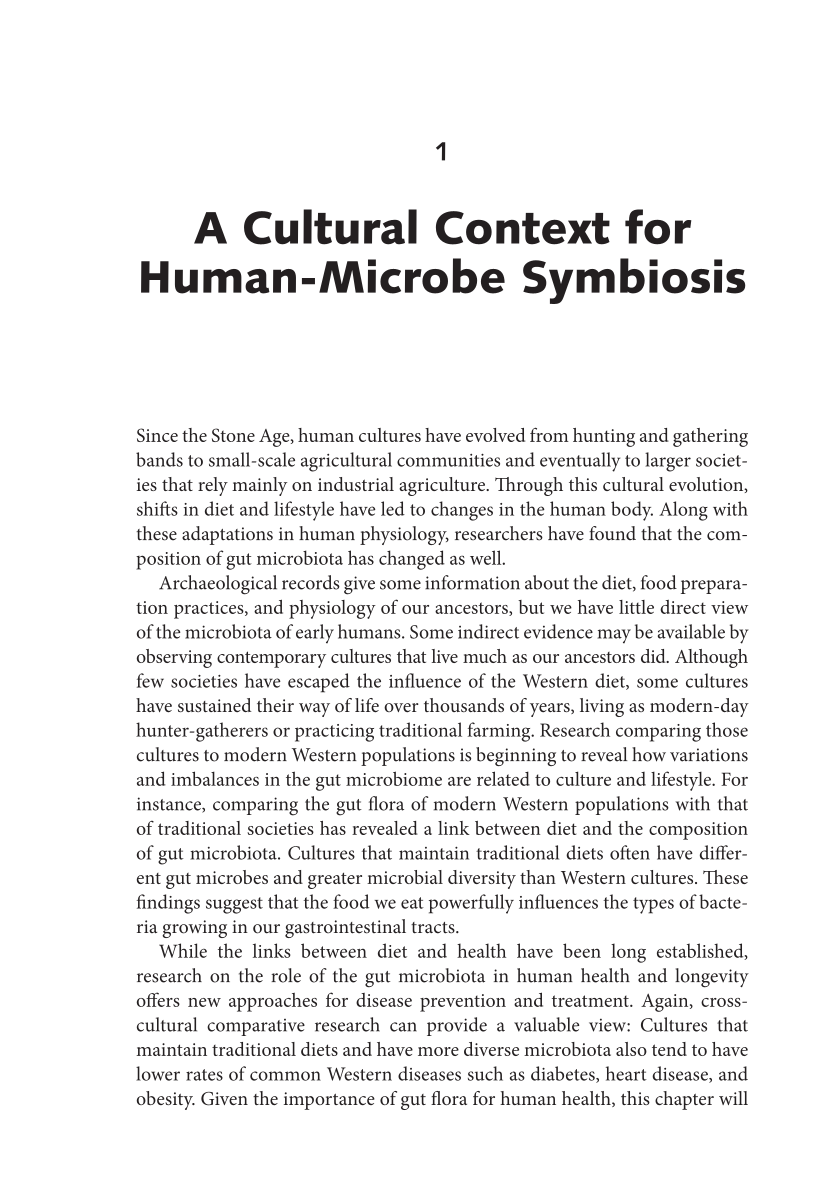1
A Cultural Context for
Human-Microbe Symbiosis
Since the Stone Age, human cultures have evolved from hunting and gathering
bands to small-scale agricultural communities and eventually to larger societ-
ies that rely mainly on industrial agriculture. Through this cultural evolution,
shifts in diet and lifestyle have led to changes in the human body. Along with
these adaptations in human physiology, researchers have found that the com-
position of gut microbiota has changed as well.
Archaeological records give some information about the diet, food prepara-
tion practices, and physiology of our ancestors, but we have little direct view
of the microbiota of early humans. Some indirect evidence may be available by
observing contemporary cultures that live much as our ancestors did. Although
few societies have escaped the influence of the Western diet, some cultures
have sustained their way of life over thousands of years, living as modern-day
hunter-gatherers or practicing traditional farming. Research comparing those
cultures to modern Western populations is beginning to reveal how variations
and imbalances in the gut microbiome are related to culture and lifestyle. For
instance, comparing the gut flora of modern Western populations with that
of traditional societies has revealed a link between diet and the composition
of gut microbiota. Cultures that maintain traditional diets often have differ-
ent gut microbes and greater microbial diversity than Western cultures. These
findings suggest that the food we eat powerfully influences the types of bacte-
ria growing in our gastrointestinal tracts.
While the links between diet and health have been long established,
research on the role of the gut microbiota in human health and longevity
offers new approaches for disease prevention and treatment. Again, cross-
cultural comparative research can provide a valuable view: Cultures that
maintain traditional diets and have more diverse microbiota also tend to have
lower rates of common Western diseases such as diabetes, heart disease, and
obesity. Given the importance of gut flora for human health, this chapter will
A Cultural Context for
Human-Microbe Symbiosis
Since the Stone Age, human cultures have evolved from hunting and gathering
bands to small-scale agricultural communities and eventually to larger societ-
ies that rely mainly on industrial agriculture. Through this cultural evolution,
shifts in diet and lifestyle have led to changes in the human body. Along with
these adaptations in human physiology, researchers have found that the com-
position of gut microbiota has changed as well.
Archaeological records give some information about the diet, food prepara-
tion practices, and physiology of our ancestors, but we have little direct view
of the microbiota of early humans. Some indirect evidence may be available by
observing contemporary cultures that live much as our ancestors did. Although
few societies have escaped the influence of the Western diet, some cultures
have sustained their way of life over thousands of years, living as modern-day
hunter-gatherers or practicing traditional farming. Research comparing those
cultures to modern Western populations is beginning to reveal how variations
and imbalances in the gut microbiome are related to culture and lifestyle. For
instance, comparing the gut flora of modern Western populations with that
of traditional societies has revealed a link between diet and the composition
of gut microbiota. Cultures that maintain traditional diets often have differ-
ent gut microbes and greater microbial diversity than Western cultures. These
findings suggest that the food we eat powerfully influences the types of bacte-
ria growing in our gastrointestinal tracts.
While the links between diet and health have been long established,
research on the role of the gut microbiota in human health and longevity
offers new approaches for disease prevention and treatment. Again, cross-
cultural comparative research can provide a valuable view: Cultures that
maintain traditional diets and have more diverse microbiota also tend to have
lower rates of common Western diseases such as diabetes, heart disease, and
obesity. Given the importance of gut flora for human health, this chapter will























































































































































































































